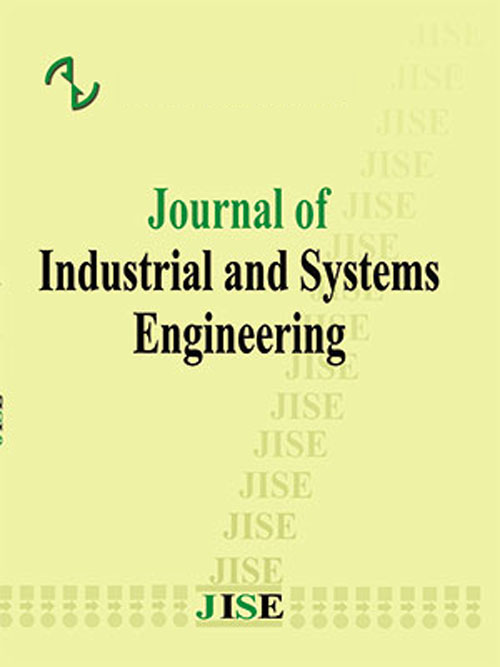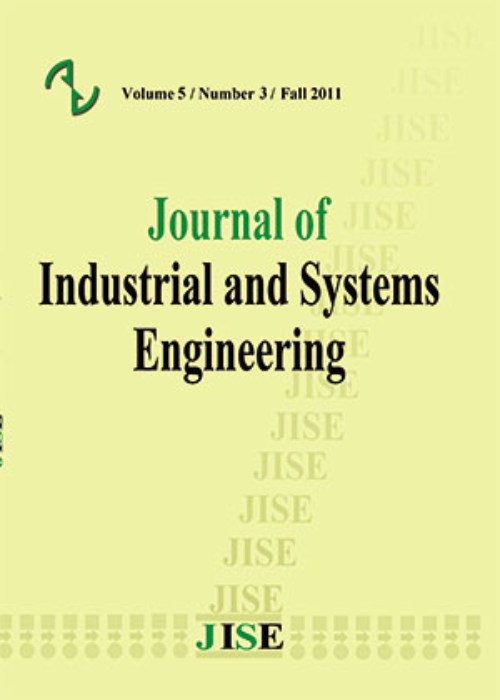فهرست مطالب

Journal of Industrial and Systems Engineering
Volume:9 Issue: 2, Spring 2016
- special issue on location allocation and hub modeling
- تاریخ انتشار: 1395/02/30
- تعداد عناوین: 7
-
-
Page 1In this paper, a complete review of published researches about hierarchical facility location and hub network problems is presented. Hierarchical network is a system where facilities with different service levels interact in a top-down way or vice versa. In Hierarchical systems, service levels are composed of different facilities. Published papers from (1970) to (2015) have been studied and a comprehensively classified and surveys is presented. Mathematical models are classified based on different properties such as: input, output, objective functions, constraints, applications, some of the real world case studies and solution methods. At the ends, according to classification, a conclusion based on the literature and the future research to tackle real world of hierarchical facility location problems and hierarchical hub network problems is presented. This study may be used as a comprehensive reference for researchers in the hierarchical facility location problems, particularly those of hierarchical location-based on hub networks.Keywords: Hub, Spoke, Hierarchical FacilityLocation (HFLPs), Hierarchical Hub Network Problems (HHNPs), Review
-
Page 23Hubs are facilities to collect arrange and distribute commodities in telecommunication networks, cargo delivery systems, etc. In this paper, an uncapacitated phub center problem in case of single allocation and also multiple allocation will be introduced in which travel times or transportation costs are considered as fuzzy parameters. Then, by proposing new methods, the presented problem is converted to deterministic mixed integer programming (MIP) problems where these methods will be obtained through the implementation of the possibility theory and fuzzy chance-constrained programming. Both possibility and necessity measures are considered separately in the proposed new methods. Finally, the proposed methods are applied on the popular CAB data set. The computational results of our study show that these methods can be implemented for the phub center problem with uncertain frameworks.Keywords: phub center, fuzzy chance, constrained programming, Uncertainty, hub location
-
Page 40This paper presents a multiobjective continuous covering location problem in fuzzy environment. Because of uncertain covering radius, possibility of covering concept is introduced.Since, the uncertainty may cause risk of uncovering customers; the problemis formulated as a risk management model. The presented model is an extension of the discrete covering location models tocontinuous space. Two variables, namely, selecting zone variable and covering variableare introduced for extending the discrete model to the continuous one. In the model, a facility is locatedin a zone with a predetermined radius from its center and is determined by the selecting zonevariable. Allocating a customer to a facility is shown by the covering variable. Also, the paperintroduces the possibility of covering based on distance between the customers and the facilities. Two objectives are considered in the model; the first is the possibility of covering by each facility and the second is the risk cost of the uncovered customers.Then, a fuzzy programming is applied for converting the model to a single objective one. Finally, a numerical examplewith sensitivity analysis is expressed to illustrate the presented model.Keywords: continuous covering location problem (CCLP), risk management, fuzzy covering radius, multiobjective problem
-
Page 53Covering models have found many applications in a wide variety of real-world problems; nevertheless, some assumptions of covering models are not realistic enough. Accordingly, a general approach would not be able to answer the needs of encountering varied aspects of real-world considerations. Assumptions like the unavailability of servers, uncertainty, and evaluating more factors at the same time, are a sort of assumptions, with which covering models are always faced; however, these models are not able to find any answers for them. Therefore, how to deal with these sorts of assumptions has been always a big question. In this research, for facing unavailability and uncertainty in input data, backup covering and interval full-ranking model were addressed, respectively. Furthermore, by combining backup covering and interval full-ranking models (also conceptions), not only time was saved and more factors like efficiency and cost were simultaneously evaluated, but also covering considerations were reachable in real aspects.Keywords: Emergency service, Backup coverage, Interval full, ranking, Meta, heuristic algorithm, Multi, objective Optimization
-
Page 71This paper proposes a discrete capacitated covering location-allocation model for pharmaceutical centers. In the presented model, two objectives are considered; the first one is minimization of costs and the second one try to maximize customer satisfaction by definition of social justice. Social justice in the model means that we consider customers satisfaction by using distance. the introduced model is an extension of the maximum covering model by adding zone constraint that Actually the distance between facility and customer zone is categorized as best, possible and not possible location. The model tries to locate facilities in best and possible location. In addition, number of missed customers is important and the model considered this issue. Since the nature of the demand is uncertain, a robust approach is proposed. The model could applied to other industries that have limitation about their product such as perishability foods or other perishability product. The model solved by GAMS Software. Finally, a numerical example with sensitivity analysis presented to illustrate the proposed model.Keywords: pharmaceutical centers, covering location, allocation problem, robust approach
-
Page 85From the most important issues in the design of large logistics network in times of crisis are providing a timely quick reaction for treating of injured people and the rapid distribution of medicines and medical equipment. In this paper, a multi-objective model is presented that aims to determine the location of transfer points and hospitals to provide timely quick reaction for treating injured people as well as to determine unreliable and reliable depots for the distribution of medicines and medical equipment. Given that the dynamic nature of the great crises, the parameters of the model has considered as uncertain and dynamic. To solve the model, the hybrid meta-heuristic algorithm is proposed which is composed of simulated annealing algorithm and CPLEX. By comparing the results can be seen that the proposed meta-heuristic hybrid algorithm is efficient.Keywords: Location, allocation, Emergency medical services logistics, Hybrid meta, heuristic algorithm, Major crises
-
Page 100This paper aims to propose a reliable location-allocation model where facilities are subject to the risk of disruptions. Since service facilities are expected to satisfy random and heavy demands, we model the congested situations in the system within a queuing framework which handles two sources of uncertainty associated with demand and service. To insure the service quality, a minimum limit reflected in the customers expected waiting time is considered in the model. We also consider the geographical accessibility of the service network in terms of the proximity of a facility to the potential demands. The model determines the optimal number and locations of facilities and the corresponding customer assignments in such a way as to minimize the fixed installation cost as well as expected traveling, serving and penalty costs. To obtain exact solution of the proposed model, a Benders decomposition algorithm enhanced by two efficient accelerating methods including valid inequalities and knapsack inequalities is proposed. Numerical results illustrate the applicability of the proposed model as well as the effectiveness of the designed solution procedure.Keywords: Location, allocation model, Disruption, Queuing system, Service quality, Geographical accessibility, Benders decomposition


